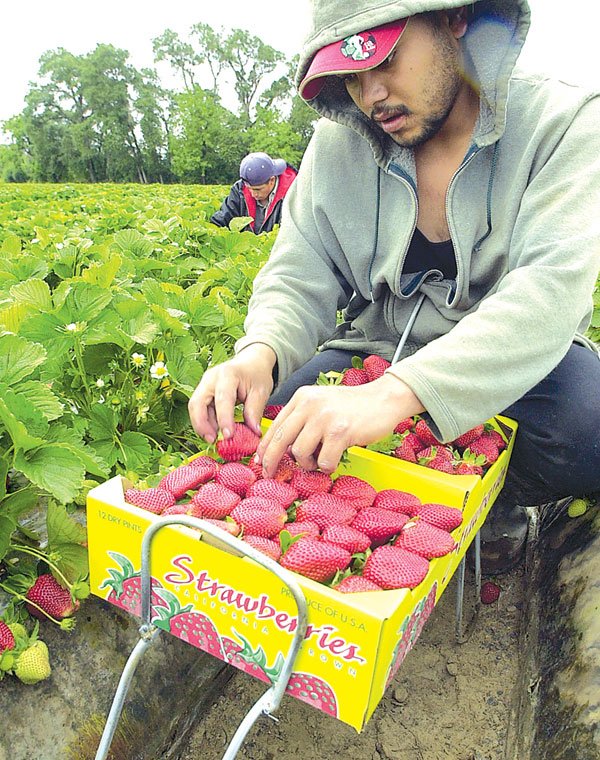GILROY
– In his 32 years of farming in the South Valley, only a few
times has Kip Brundage seen the weather wreak havoc on his hay
crops like it has this year.
GILROY – In his 32 years of farming in the South Valley, only a few times has Kip Brundage seen the weather wreak havoc on his hay crops like it has this year.
“I saw this in 1977 when it rained through the entire month of May,” said Brundage, the president of the South Santa Clara County Farm Bureau and owner of G&K Farms in Gilroy. “Five years ago it rained all the way until June.”
While farmers expect and hope for a nearly dry and warm April and May, last month more than 2.5 inches of rain fell in Gilroy and sporadic rains have continued into this month, causing all kinds of problems for fruit and vegetable growers all across the area.
“This is a disaster,” Brundage said. “We’re not like the Midwest and flooded, but at one point you might as well be. It’s not just hurting us a little, it’s hurting us a lot.”
Brundage said his hay fields need seven days of dry, warm weather to be harvested, but with rain falling almost every other day, the hay has started laying down as the heads become too saturated and heavy.
“The quality of the crops is decreasing, and any continuing of this weather would ruin them,” he said.
When asked if there was anything a farmer could do to alleviate the problem, the answer was simple.
“No.”
While Brundage can’t harvest his crop and slowly watches the quality of his product plummet, other farmers are seeing problems of their own. Lettuce growing in the fields has become moldy; wheat growers are losing as much as half of their crop; the sod business is down 40 percent, and farmers are unable to harvest grass; and stone fruits, like apricots or cherries, have suffered from a mild winter that made trees bloom sporadically and didn’t give the fruit time to set.
Strawberry farmers, like Tim Chiala, may be suffering the worst out of everyone, reporting their lowest yields in years.
“Instead of picking 200 to 300 boxes per day, were doing 100 boxes two or three times a week,” said Chiala, who has 17-acres of his George Chiala Farms in Morgan Hill used for growing strawberries and also grows garlic, corn and bell peppers. “There’s not much you can do, you can’t cultivate, you can’t spray for insects.”
Not only are the yields low, but the strawberries get marked up from the rain and can mold if there is too much water.
Chiala said he invests $5,000 to $10,000 per acre on strawberries, but will probably be coming up negative on his return.
“It’s not up to you,” he said. “You just hope it gets sunny, and you hope some wind picks up to dry it out after it rains.”
Brundage and several other area farmers continue to wait by their fax machines or make phone calls each morning to get a weather report from meteorologists like Terry Snow, who works out of San Miguel.
Unfortunately, those weather reports haven’t been good news for the last few months and isn’t going to get better in the new future. According to Snow, the rains, although dropping in intensity, could go on for another month or more.
“There’s a blocking high pressure center over British Columbia that is splitting the jet stream in half,” Snow explained. “It should be focused over Oregon and Washington, but instead it is going over you guys. … And it will probably last all the way into mid-June.”
The below-average temperatures also have affected Don Hordness’ mushrooms. Although he grows them indoors at Del Fresh Mushrooms in Morgan Hill, Hordness said that he uses heating or air conditioning as a way to control humidity, usually cooling 70-degree air at this time of year to a better growing temperature of 63 degrees. But with temperatures in the low 60s, Hordness can’t use air conditioning to suck the water out of the air, which can lead to bacteria growing on the mushrooms.
“It’s harder for us to dry out our product,” Hordness said. “There are natural bacterias in the air. When the conditions are right, they grow much faster and that becomes a problem.”
The weather also has affected summer crops. Brundage said he heard that one farmer had 7 million corn transplants that he wasn’t able to get into the ground because of the conditions.
“These guys need to be harvesting by the beginning of July, but they missed it,” Brundage said. “It’s like the flower growers missing Mother’s Day, or the department stores missing Christmas. Our crops are popular at certain times.”
While that doesn’t necessarily mean that people in the South Valley won’t be able to have corn on the cob for their Fourth of July barbecues, it does mean there’s a better chance that it, and other fruits and vegetables, won’t be home-grown.
“What it means for the consumer is they just import it out of Mexico,” Brundage said. “They still get the product, but they don’t get the quality.
“It has helped with not needing to do irrigation, but we need the water in a timely manner. If we could see a light at the end of the tunnel, it wouldn’t be so bad,” Brundage said. “But we don’t see any light.”













